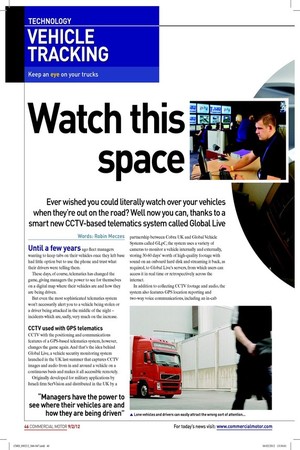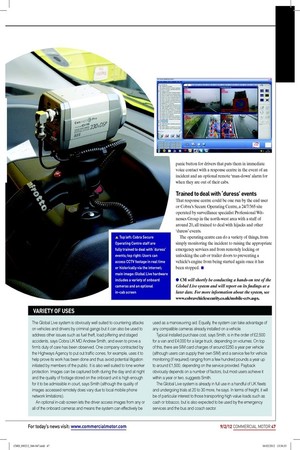TECHNOLOGY
Page 38

Page 39

If you've noticed an error in this article please click here to report it so we can fix it.
VEHICLE TRACKING
Keep an eye on your trucks
atch this space
Ever wished you could literally watch over your vehicles when they’re out on the road? Well now you can, thanks to a smart new CCTV-based telematics system called Global Live
Words: Robin Meczes Until a few years ago leet managers wanting to keep tabs on their vehicles once they left base had little option but to use the phone and trust what their drivers were telling them.
These days, of course, telematics has changed the game, giving managers the power to see for themselves on a digital map where their vehicles are and how they are being driven.
But even the most sophisticated telematics system won’t necessarily alert you to a vehicle being stolen or a driver being attacked in the middle of the night – incidents which are, sadly, very much on the increase.
CCTV used with GPS telematics
CCTV with the positioning and communications features of a GPS-based telematics system, however, changes the game again. And that’s the idea behind Global Live, a vehicle security monitoring system launched in the UK last summer that captures CCTV images and audio from in and around a vehicle on a continuous basis and makes it all accessible remotely.
Originally developed for military applications by Israeli irm SerVision and distributed in the UK by a partnership between Cobra UK and Global Vehicle Systems called GLpC, the system uses a variety of cameras to monitor a vehicle internally and externally, storing 30-60 days’ worth of high-quality footage with sound on an onboard hard disk and streaming it back, as required, to Global Live’s servers, from which users can access it in real time or retrospectively across the internet.
In addition to collecting CCTV footage and audio, the system also features GPS location reporting and two-way voice communications, including an in-cab panic button for drivers that puts them in immediate voice contact with a response centre in the event of an incident and an optional remote ‘man-down’ alarm for when they are out of their cabs.
Trained to deal with ‘duress’ events
That response centre could be one run by the end user or Cobra’s Secure Operating Centre, a 24/7/365 site operated by surveillance specialist Professional Witnesses Group in the north-west area with a staff of around 20, all trained to deal with hijacks and other ‘duress’ events.
The operating centre can do a variety of things, from simply monitoring the incident to raising the appropriate emergency services and from remotely locking or unlocking the cab or trailer doors to preventing a vehicle’s engine from being started again once it has been stopped. n ● CM will shortly be conducting a hands-on test of the Global Live system and will report on its ,lindings at a later date. For more information about the system, see www.cobravehiclesecurity.co.uk/mobile-cctv.aspx.
VARIETY OF USES
The Global Live system is obviously well suited to countering attacks on vehicles and drivers by criminal gangs but it can also be used to address other issues such as fuel theft, load pilfering and staged accidents, says Cobra UK MD Andrew Smith, and even to prove a firm’s duty of care has been observed. One company contracted by the Highways Agency to put out traffic cones, for example, uses it to help prove its work has been done and thus avoid potential litigation initiated by members of the public. It is also well suited to lone worker protection. Images can be captured both during the day and at night and the quality of footage stored on the onboard unit is high enough for it to be admissible in court, says Smith (although the quality of images accessed remotely does vary due to local mobile phone network limitations).
An optional in-cab screen lets the driver access images from any or all of the onboard cameras and means the system can effectively be used as a manoeuvring aid. Equally, the system can take advantage of any compatible cameras already installed on a vehicle.
Typical installed purchase cost, says Smith, is in the order of £2,500 for a van and £4,000 for a large truck, depending on volumes. On top of this, there are SIM card charges of around £250 a year per vehicle (although users can supply their own SIM) and a service fee for vehicle monitoring (if required) ranging from a few hundred pounds a year up to around £1,500, depending on the service provided. Payback obviously depends on a number of factors, but most users achieve it within a year or two, suggests Smith.
The Global Live system is already in full use in a handful of UK fleets and undergoing trials at 20 to 30 more, he says. In terms of freight, it will be of particular interest to those transporting high value loads such as cash or tobacco, but is also expected to be used by the emergency services and the bus and coach sector.











































